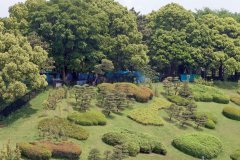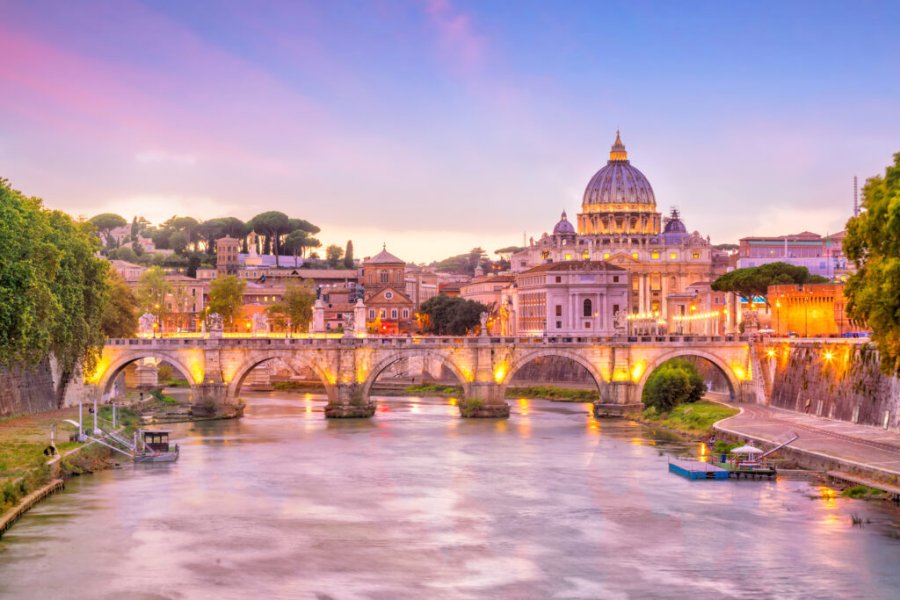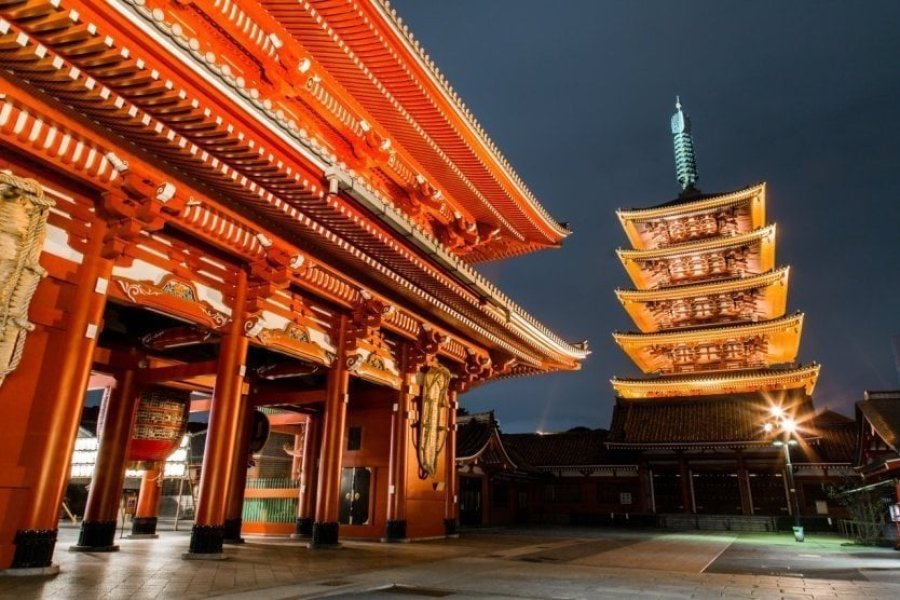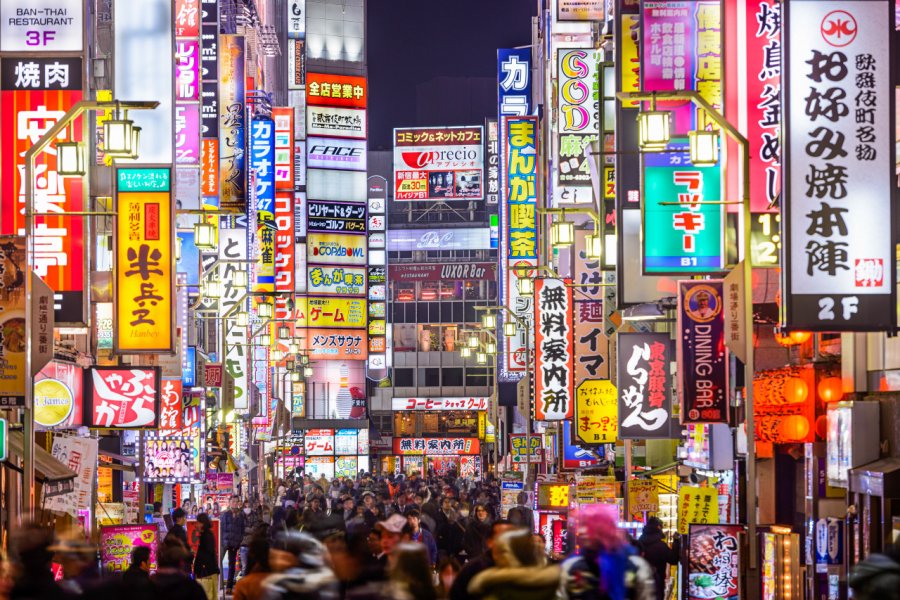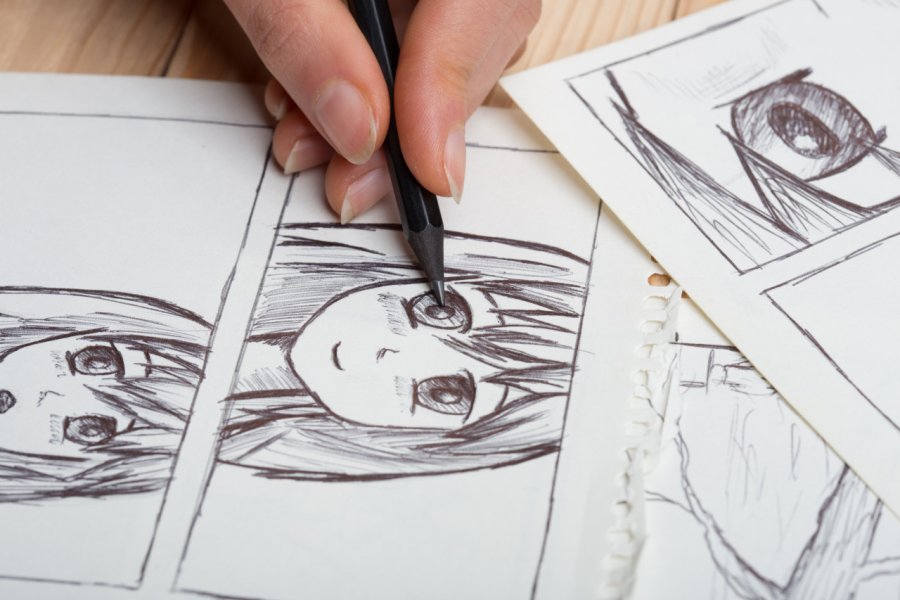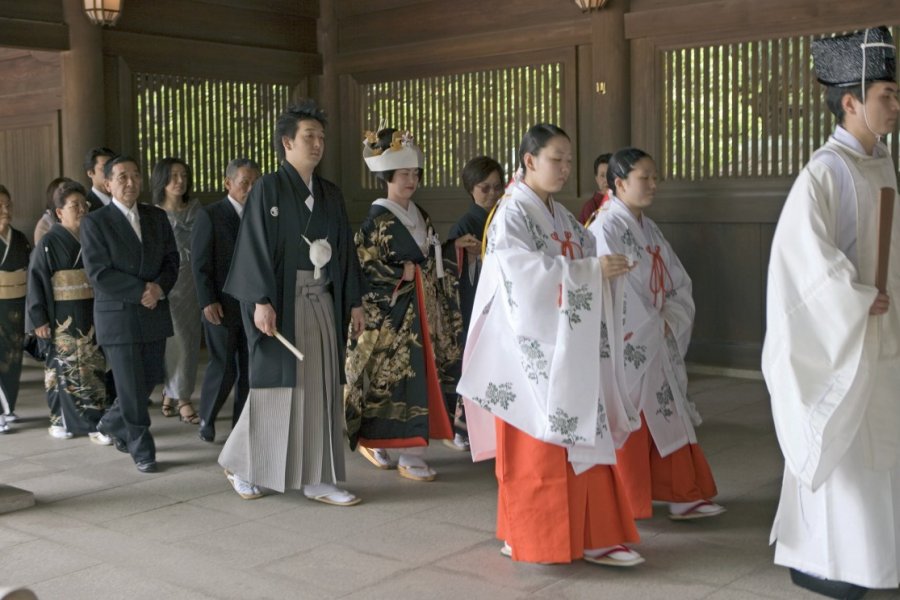Travel guide Tokyo
The discovery of the capital of Japan is a great shock. This city is exciting, bubbling, incredible and without equal in the world! Within the gigantic Tōkyō lie ultra-modern districts with skyscrapers competing in audacity and elegance and residential districts with traditional houses and Shinto temples, with small holy statues at a street crossing and a bicycle path along a canal... Here modernism meets tradition. We leave a five-storey store dedicated to cameras only to eat in a small restaurant in udon house. If high-tech is a religion here, so is citizenship, which police actions and all excesses. Not a hair protrudes! Nobody pushes you around on the subway. No one misses their train! Tōkyō is also the pleasure of eating Japanese delicacies on every street corner and making your bento to your liking, of finding a small shop selling second-hand kimonos, of discovering a craftsman who prepares, in the tradition, fresh tofu every day. Of course, you will visit the sanctuary shintō Meiji at the imposing gate and the surrounding woods and public gardens dominated by the Imperial Palace (Kōkyo), not to mention keeping time to discover the collections of the city's museums. For a great moment, treat yourself to a ryokan (traditional inn) or a bath in the hot springs of the surroundings. And it's better to plan it: you'll come back with Japanese dishes!
What to see, what to do Tokyo?
-
Book an activity
-
Customized travel
- Addresses to visit Tokyo
When to go Tokyo ?
As in all major capitals, stays in Tokyo can be planned throughout the year. However, spring and autumn are the high tourist seasons during which hotel rates are highest. Since accommodation is the most important budgetary expenditure in Japan, it may be interesting to go out of season. To avoid the highest crowds and pay less, the best period is late November-early December, late February-early March, or late May and June, the low tourist season in Japan. Note that if you go to Japan in the spring, you will have the pleasure of attending Hanami, the festival that celebrates cherry blossoms. The spectacle of this flowering will enchant you!
Weather at the moment
Suggested addresses Tokyo
Travel Tokyo
-
Find a hotel
-
Car Rental
-
International e-SIM package
-
Find a local agency
Find unique Stay Offers with our Partners
How to go Tokyo
How to go alone
Traveling alone is not a problem, Japan is one of the safest countries in the world and Japanese people are always ready to help tourists. The only problem is the language because the Japanese almost never speak English, let alone French! Think of bringing a small dictionary or using Google translation!
How to go on a tour
For Japan in general and Tokyo in particular, the offer is very large. We propose the discovery of the triptych Tokyo, Kyoto, Nara in one week. Contrary to popular belief, the smallest budgets will be able to find a one-month package in Tokyo at a reasonable price (with accommodation in a university residence).
How to get around
The best way to get around the huge Tokyo is definitely the subway. Simple and efficient. The stations are written in English and announced in the same way inside your train. Take a pass without which (and even with!) you will ruin yourself in travel. Taking a bus can be convenient. Cycling in the neighborhoods is a good solution. If you want to discover Kyoto or any other city served by a train, take the high speed train (Shinkasen).
Featured articles Tokyo
Discover Tokyo
We all have echoes of Japan, through words like manga, geisha, sushi, zen or karate, which have been exported around the world and sketch the first images of a fantasized Japan. A visit to Tokyo means discovering all the worlds that lie behind these terms, grasping the thousand and one forms that Japanese society takes beyond all our preconceived ideas, and, perhaps, getting carried away in a whirlwind of new things. Closely linked to Buddhism and neighboring China, the history of the archipelago, which was relatively closed to foreign influences for almost 300 years, has led to the emergence of a culture apart, whether artistic, culinary or social. Japanese concepts such as wabi-sabi and Zen never cease to question and fascinate. A trip to Japan is the perfect opportunity to grasp a little of this culture, and here we give you a few keys.
Pictures and images Tokyo
The 12 keywords Tokyo
1. #Kawaii

The Japanese cultivate the art of "kawaii", the cute, the harmless. In Hello Kitty's homeland, it's as much a form of artistic expression as a lucrative industry. People, animals and objects take on round, childlike features, and everything is tinted in fluorescent or pastel colors. Even the police have their own kawaii mascots.
2. #Konbini
Supermarkets open 24/7 are literally on every street corner in Tokyo. They're handy for grabbing a quick bite to eat, withdrawing cash, going to the toilet or even buying last-minute souvenirs. In the evening, they shine like beacons in the night, around which partygoers gather.
3. #Mangas

An essential part of Japanese culture, manga are comics that were first published in magazines, covering a wide range of subjects and appealing to all audiences. They are at the heart of a major industry, which is also supported by the sale of derivative products. The scale of the phenomenon extends far beyond Japan's borders.
4. #Matsuri
Festivals punctuate the Japanese year. Traditionally linked to the agricultural seasons, they are now organized by temples and shrines. There's a whole range of them, but those involving an o-mikoshi are very common. The richly decorated palanquin houses the local deity for the duration of a tour of the neighborhood.
5. #Minimalism
Marie Kondo, the tidying fairy, has been a bombshell abroad, but here she's an epiphenomenon as the cleanliness and tidiness sector is so saturated with stars publishing their advice. In a society of hyper-consumption, minimalism drawing on values of simplicity inspired by Zen Buddhism is increasingly appealing.
6. #Mount Fuji

The mythical Japanese mountain and symbol of the country, Mount Fuji rises to 3,776 metres and is one of Japan's 3 sacred mountains. A place of pilgrimage sung by poets and sublimated by artists, the volcano and its near-perfect conical shape continue to fascinate. Located 100 km south-west of Tokyo, it can be seen on a clear day.
7. #Omotenashi
Developed with the tea ceremony, Japanese-style service elevates the art of welcoming guests to an art form. Everything revolves around the customer, who is served with care. From the shop assistant who wraps your groceries in tissue paper to the hotelier who carefully prepares futons for the night, omotenashi is pervasive throughout society.
8. #Robot
Japan is a world leader in the robotics industry. The use of robots is all the more crucial in view of the shortage of manpower due to demographic decline. Autonomous trucks will soon be on Japanese roads. Robotization is also affecting other sectors, such as healthcare and leisure.
9. #Shinto
The "way of the gods" is a set of ancient beliefs according to which the elements of nature are inhabited by kami, deities not always benevolent, in the image of nature. Shinto long existed in symbiosis with Buddhism, but in the 19th century the two religions were separated and Shinto became the state religion.
10. #Toilets
Access to clean toilets is easy in Japan. You'll find them in konbini, train stations and shopping malls. Most are equipped with a real dashboard with water jet, music or seat heating options. In shopping malls, they're practically beauty salons, where women put on make-up or change clothes.
11. #Tokaido
The Tokaido Road is the main route between Tokyo and Kyoto. In Edo times, it was used by the lords and their retinues who travelled to Tokyo on foot. If you take the Shinkansen to Kyoto, you'll probably take the same route as the Edo travelers... or follow in their footsteps on foot near Hakone or Shizuoka.
12. #Wabi-sabi

An essential concept in Japanese aesthetics, wabi-sabi is made up of 2 terms: wabi, or the fullness of simplicity, and sabi, the feeling of the marks of passing time and wear. It's the art of perceiving the beauty of imperfect things, exemplified in the kintsugi technique: gluing together the pieces of a broken object with gold.
You are from here, if...
You line up on subwayplatforms, train platforms and in front of restaurants.
Dressed in colorful yukata, you run to watch the fireworks in summer.
The mask is your friend. You wear it when you have a cold, are tired or look unwell, and not just when there's an epidemic.
You bow slightly to say thank you, hello or goodbye.
If you never eat while walking, you sometimes sip tea or a green tea latte from a trendy café.
You always carrya small towel with you to mop up sweat or dry your hands.
Your shoes are lined up and turned in the direction you put them on when you take your shoes off at the entrance. Besides, you only have shoes that are easy to take off and put on.
You overuse sumimasen, "excuse me". It can mean please, sorry or thank you.
Soccer is good, but baseball is better! You all know the exploits of Shohei Ohtani.

